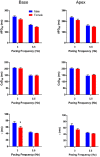Sex differences in β-adrenergic responsiveness of action potentials and intracellular calcium handling in isolated rabbit hearts
- PMID: 25340795
- PMCID: PMC4207827
- DOI: 10.1371/journal.pone.0111411
Sex differences in β-adrenergic responsiveness of action potentials and intracellular calcium handling in isolated rabbit hearts
Abstract
Cardioprotection in females, as observed in the setting of heart failure, has been attributed to sex differences in intracellular calcium handling and its modulation by β-adrenergic signaling. However, further studies examining sex differences in β-adrenergic responsiveness have yielded inconsistent results and have mostly been limited to studies of contractility, ion channel function, or calcium handling alone. Given the close interaction of the action potential (AP) and intracellular calcium transient (CaT) through the process of excitation-contraction coupling, the need for studies exploring the relationship between agonist-induced AP and calcium handling changes in female and male hearts is evident. Thus, the aim of this study was to use optical mapping to examine sex differences in ventricular APs and CaTs measured simultaneously from Langendorff-perfused hearts isolated from naïve adult rabbits during β-adrenergic stimulation. The non-selective β-agonist isoproterenol (Iso) decreased AP duration (APD90), CaT duration (CaD80), and the decay constant of the CaT (τ) in a dose-dependent manner (1-316.2 nM), with a plateau at doses ≥31.6 nM. The Iso-induced changes in APD90 and τ (but not CaD80) were significantly smaller in female than male hearts. These sex differences were more significant at faster (5.5 Hz) than resting rates (3 Hz). Treatment with Iso led to the development of spontaneous calcium release (SCR) with a dose threshold of 31.6 nM. While SCR occurrence was similar in female (49%) and male (53%) hearts, the associated ectopic beats had a lower frequency of occurrence (16% versus 40%) and higher threshold (100 nM versus 31.6 nM) in female than male hearts (p<0.05). In conclusion, female hearts had a decreased capacity to respond to β-adrenergic stimulation, particularly under conditions of increased demand (i.e. faster pacing rates and "maximal" levels of Iso effects), however this reduced β-adrenergic responsiveness of female hearts was associated with reduced arrhythmic activity.
Conflict of interest statement
Figures






References
-
- Brodde OE, Bruck H, Leineweber K (2006) Cardiac adrenoceptors: physiological and pathophysiological relevance. J Pharmacol Sci 100: 323–337. - PubMed
-
- Triposkiadis F, Karayannis G, Giamouzis G, Skoularigis J, Louridas G, et al. (2009) The sympathetic nervous system in heart failure physiology, pathophysiology, and clinical implications. J Am Coll Cardiol 54: 1747–1762. - PubMed
-
- Florea VG, Cohn JN (2014) The Autonomic Nervous System and Heart Failure. Circ Res 114: 1815–1826. - PubMed
-
- Adams KF Jr, Sueta CA, Gheorghiade M, O′Connor CM, Schwartz TA, et al. (1999) Gender differences in survival in advanced heart failure. Insights from the FIRST study. Circulation 99: 1816–1821. - PubMed
Publication types
MeSH terms
Substances
Grants and funding
LinkOut - more resources
Full Text Sources
Other Literature Sources
Miscellaneous

